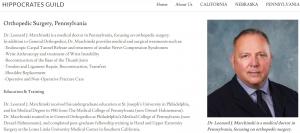Carpal Tunnel Syndrome, a common condition of hand and arm, explained by orthopedic surgeon Dr. Leonard Marchinski
Carpal Tunnel Syndrome – What Is It? In a new article written in layman’s terms, orthopedic surgeon Dr. Leonard Marchinski provides insight
LEONARD JOSEPH MARCHINSKI, M.D. (N/A:N/A)
Dr. Leonard J. Marchinski is providing his insights in a new article. The complete article will be available on Dr. Marchinski’s blog at https://leonardmarchinskimd.wordpress.com/
What Is Carpal Tunnel Syndrome?
A type of Entrapment neuropathy – a condition caused when a peripheral nerve of the body gets pressed due to some reason - Carpal Tunnel Syndrome is quite common and is caused by the pressure on the median nerve.
The Median Nerve is one of the three major nerves that run through the forearm and hand. It innervates i.e. supply nerves to the hand’s intrinsic muscles, thereby, controlling the feeling and movement of fingers (expect the smallest one) and thumb and the coarse movements of the hand. This is why it is also called the “laborer’s nerve” or “eye of the hand.”
The Median Nerve enters the hand through a narrow passageway, called Carpal tunnel, located at the base of the hand on palm side of the wrist. The Carpal Tunnel is made of bones and ligaments and along with the median nerve, it also houses tendons that make bending of fingers possible.
The narrowing of the Carpal Tunnel, usually due to swelling, puts pressure on the median nerve and compresses it. As a result, the person may experience weakness, numbness, and sometimes, pain in the wrist and hand. Occasionally, the pain can spread to the forearm and arm.
Causes of Carpal Tunnel Syndrome
A variety of factors can initiate the narrowing of Carpal tunnel and contribute to the condition. These include repetitive movements of hands or wrists, for example, typing especially when the wrists are higher than hands.
Due to the nature of their job that includes repetitive hand motions, certain professionals are at a higher risk of developing Carpal Tunnel Syndrome. They include musicians, tailors, knitters, bakers, hair stylists, cashiers, typists, and assembly line workers.
Some health conditions also increase a person’s risk to get affected by the Carpal Tunnel syndrome. These include:
* Rheumatoid arthritis
* Obesity
* Hypothyroidism
* Diabetes
* Trauma
* Pregnancy
Symptoms of Carpal Tunnel Syndrome
When the condition starts to develop, the patient may first experience numbness in fingers at night when the hands are in relaxed position. The patient may wake up in the morning with numb hands or experience tingling that runs from hands to the shoulders.
Carpal Tunnel Syndrome is generally characterized by an itching numbness, tingling, and/or burning feeling in the index and middle finger, thumb, or palm. If not treated at earlier stages, the condition can get severe and can lead to the shrinking of muscles in the affected hand. This can cause:
* Reduced grip strength
* Severe muscle pain
* Increased and more painful muscle cramping
Over time, the condition can cause the median nerve to lose its function, which then can lead to:
* Loss of feelings in fingers
* Reduced or loss of coordination and strength of hand. In particular, the patient can lose the ability to use thumb to pinch
* Slowed nerve impulses
In the worst case, the hand can completely stop functioning. This is why it is highly recommended to not ignore the signs and symptoms of Carpal Tunnel Syndrome and see a doctor as soon as possible.
Carpal Tunnel Syndrome Treatment
Depending on the severity of the condition, the treatment of Carpal Tunnel Syndrome includes one or a combination of the following:
* Immobilization
The patients of Carpal Tunnel Syndrome are generally advised to wear a splint to reduce or prevent movement of wrist. This will decrease the pressure on median nerve and will provide symptomatic relief. In most cases, the patients are advised to wear the splint at night to prevent the tingling feeling and the numbing of fingers and hand.
* Lifestyle Changes
In cases where the condition is caused due to repetitive motions, the person is told to stop or reduce the activity, if possible. If this is not possible, the doctor generally recommends taking frequent breaks from the work to rest your arm and hand.
* Medications
Since swelling is a major factor in Carpal tunnel syndrome, the doctor may prescribe anti-inflammatory drugs or steroid shots.
* Surgery
In cases where no other treatment works, the doctor may recommend surgery.
Final Word
Carpal tunnel syndrome is more common than we think and the fact that many a times it is caused by our daily activities puts most of us at the risk of it. While there are treatments available for Carpal Tunnel Syndrome, it is better to take preventive measures if you have to perform repetitive motions with your hands, on daily basis. Be very careful about the position of your hands and wrists. Make sure your wrists are always straight and, if possible, wear a splint to ensure your wrists stay in neutral positions. Talk to your doctor and ask if there is any exercise that can help prevent Carpal Tunnel Syndrome.
About Leonard Joseph Marchinski, MD
Dr. Leonard Marchinski is a medical doctor in Pennsylvania, focusing on orthopedic surgery. In addition to General Orthopedics, Dr. Marchinski provides medical and surgical treatments such as:
* Endoscopic Carpal Tunnel Release and treatment of similar Nerve Compression Syndromes
* Wrist Arthroscopy and treatment of Wrist Instability
* Reconstruction of the Base of the Thumb Joint
* Tendon and Ligament Repair, Reconstruction, Transfers
* Shoulder Replacement
* Operative and Non-Operative Fracture Care
Dr. Leonard J. Marchinski received his undergraduate education at St. Joseph’s University in Philadelphia (Biology, 1974-1977), and his Medical Degree in 1981 from The Medical College of Pennsylvania (now Drexel-Hahnemann).
References
Website: https://leonardmarchinskimd.com/
Video: https://video.vitals.com/Dr_Leonard_Marchinski.mp4
Blog: https://leonardmarchinskimd.wordpress.com/
News: https://medicogazette.com/dr-leonard-j-marchinski#79296231-68fa-4702-9a29-11f9238139ea
News: https://hippocratesguild.com/dr-leonard-j-marchinski
News: https://hype.news/leonardmarchinskimd/
Reference: https://health.usnews.com/doctors/leonard-marchinski-253046
LinkedIn: https://www.linkedin.com/in/dr-leonard-marchinski-174236181/
Dr. Leonard J. Marchinski
LEONARD JOSEPH MARCHINSKI, M.D.
+1 484-709-1515
email us here
Visit us on social media:
LinkedIn
Carpal Tunnel Syndrome - Nucleus Health
Legal Disclaimer:
EIN Presswire provides this news content "as is" without warranty of any kind. We do not accept any responsibility or liability for the accuracy, content, images, videos, licenses, completeness, legality, or reliability of the information contained in this article. If you have any complaints or copyright issues related to this article, kindly contact the author above.





